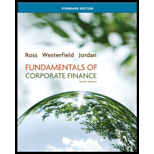
a)
To determine: The operating cash flow
Introduction:
Operating cash flow refers to the cash from operating activities or primary activities of the firm.
b)
To calculate: The cash flow to creditors
Introduction: The cash flow to creditors refers to the net payment received by the creditors of the company. It refers to the interest paid to the creditors minus the net fresh debt borrowed by the company.
c)
To calculate: The cash flow to stockholders
Introduction:
The cash flow to stockholders’ refers to the dividend paid to the shareholders of the company minus the fresh equity raised by the company. In other words, it refers to the net payment received by the shareholders of the company.
d)
To calculate: The addition to net working capital
Introduction:
Net working capital refers to the difference between the current assets and current liabilities of the company. There will be a change in net working capital due to the increase or decrease in current assets.
Want to see the full answer?
Check out a sample textbook solution
Chapter 2 Solutions
Fundamentals of Corporate Finance Standard Edition
 Essentials Of InvestmentsFinanceISBN:9781260013924Author:Bodie, Zvi, Kane, Alex, MARCUS, Alan J.Publisher:Mcgraw-hill Education,
Essentials Of InvestmentsFinanceISBN:9781260013924Author:Bodie, Zvi, Kane, Alex, MARCUS, Alan J.Publisher:Mcgraw-hill Education,

 Foundations Of FinanceFinanceISBN:9780134897264Author:KEOWN, Arthur J., Martin, John D., PETTY, J. WilliamPublisher:Pearson,
Foundations Of FinanceFinanceISBN:9780134897264Author:KEOWN, Arthur J., Martin, John D., PETTY, J. WilliamPublisher:Pearson, Fundamentals of Financial Management (MindTap Cou...FinanceISBN:9781337395250Author:Eugene F. Brigham, Joel F. HoustonPublisher:Cengage Learning
Fundamentals of Financial Management (MindTap Cou...FinanceISBN:9781337395250Author:Eugene F. Brigham, Joel F. HoustonPublisher:Cengage Learning Corporate Finance (The Mcgraw-hill/Irwin Series i...FinanceISBN:9780077861759Author:Stephen A. Ross Franco Modigliani Professor of Financial Economics Professor, Randolph W Westerfield Robert R. Dockson Deans Chair in Bus. Admin., Jeffrey Jaffe, Bradford D Jordan ProfessorPublisher:McGraw-Hill Education
Corporate Finance (The Mcgraw-hill/Irwin Series i...FinanceISBN:9780077861759Author:Stephen A. Ross Franco Modigliani Professor of Financial Economics Professor, Randolph W Westerfield Robert R. Dockson Deans Chair in Bus. Admin., Jeffrey Jaffe, Bradford D Jordan ProfessorPublisher:McGraw-Hill Education





